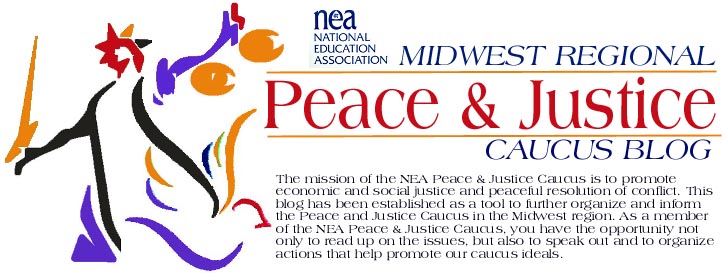 TO BUILD A WAR WORKSHOP
TO BUILD A WAR WORKSHOPAn Editorial from the NY Times
February 10, 2007
It took far too long, but a report by the Pentagon inspector general has finally confirmed that Defense Secretary Donald Rumsfeld’s do-it-yourself intelligence office cooked up a link between Iraq and Al Qaeda to help justify an unjustifiable war.
The report said the team headed by Douglas Feith, under secretary of defense for policy, developed “alternative” assessments of intelligence on Iraq that contradicted the intelligence community and drew conclusions “that were not supported by the available intelligence.” Mr. Feith certainly knew the Central Intelligence Agency would cry foul, so he hid his findings from the C.I.A. Then Vice President Dick Cheney used them as proof of cloak-and-dagger meetings that never happened, long-term conspiracies between Saddam Hussein and Osama bin Laden that didn’t exist, and — most unforgivable — “possible Iraqi coordination” on the 9/11 attacks, which no serious intelligence analyst believed.
The report said the team headed by Douglas Feith, under secretary of defense for policy, developed “alternative” assessments of intelligence on Iraq that contradicted the intelligence community and drew conclusions “that were not supported by the available intelligence.” Mr. Feith certainly knew the Central Intelligence Agency would cry foul, so he hid his findings from the C.I.A. Then Vice President Dick Cheney used them as proof of cloak-and-dagger meetings that never happened, long-term conspiracies between Saddam Hussein and Osama bin Laden that didn’t exist, and — most unforgivable — “possible Iraqi coordination” on the 9/11 attacks, which no serious intelligence analyst believed.
The inspector general did not recommend criminal charges against Mr. Feith because Mr. Rumsfeld or his deputy, Paul Wolfowitz, approved their subordinate’s “inappropriate” operations. The renegade intelligence buff said he was relieved.
We’re sure he was. But there is no comfort in knowing that his dirty work was approved by his bosses. All that does is add to evidence that the Bush administration knowingly and repeatedly misled Americans about the intelligence on Iraq.
To understand this twisted tale, it is important to recall how Mr. Feith got into the creative writing business. Top administration officials, especially Mr. Cheney, had long been furious at the C.I.A. for refusing to confirm the delusion about a grand Iraqi terrorist conspiracy, something the Republican right had nursed for years. Their frustration only grew after 9/11 and the C.I.A. still refused to buy these theories.
Mr. Wolfowitz would feverishly sketch out charts showing how this Iraqi knew that Iraqi, who was connected through six more degrees of separation to terrorist attacks, all the way back to the 1993 World Trade Center bombing.

But the C.I.A. kept saying there was no reliable intelligence about an Iraq-Qaeda link. So Mr. Feith was sent to review the reports and come back with the answers Mr. Cheney wanted. The inspector general’s report said Mr. Feith’ s team gave a September 2002 briefing at the White House on the alleged Iraq-Qaeda connection that had not been vetted by the intelligence community (the director of central intelligence was pointedly not told it was happening) and “was not fully supported by the available intelligence.”
The false information included a meeting in Prague in April 2001 between an Iraqi official and Mohamed Atta, one of the 9/11 pilots. It never happened. But Mr. Feith’s report said it did, and
Mr. Cheney will still not admit that the story is false.
In a statement released yesterday, Senator Carl Levin, the new chairman of the Senate Armed Services Committee, who has been dogged in pursuit of the truth about the Iraqi intelligence, noted that the cooked-up Feith briefing had been leaked to the conservative Weekly Standard magazine so Mr. Cheney could quote it as the “best source” of information about the supposed Iraq-Qaeda link.
The Pentagon report is one step in a long-delayed effort to figure out how the intelligence on Iraq was so badly twisted — and by whom. That work should have been finished before the 2004 elections, and it would have been if Pat Roberts, the obedient Republican who ran the Senate Intelligence Committee, had not helped the White House drag it out and load it in ways that would obscure the truth.
It is now up to Mr. Levin and Senator Jay Rockefeller, the current head of the intelligence panel, to give Americans the answers. Mr. Levin’s desire to have the entire inspector general’s report on the Feith scheme declassified is a good place to start. But it will be up to Mr. Rockefeller to finally determine how old, inconclusive, unsubstantiated and false intelligence was transformed into fresh, reliable and definitive reports — and then used by Mr. Bush and other top officials to drag the country into a disastrous and unnecessary war.




1 comment:
How can it be? I’ve just leafed through the Sunday New York Times, Feb 11, 2007, and there’s not one mention of Douglas Feith to be found. Hmm. One article on Scooter Libby, but they focused on Libby’s lawyer Theodore V. Wells, describing what a great guy he is… I’m sure their right. The NYTimes also gave Wells some pointers on how he should advance his case against Prosecutor Patrick J. Fitzgerald. Wow!
Just like the NYTimes to turn the other way when there’s a big story that doesn’t fit their agenda. I guess the thinking is… if there’s nothing nice to say about a subject we care about, why say anything at all.
Post a Comment